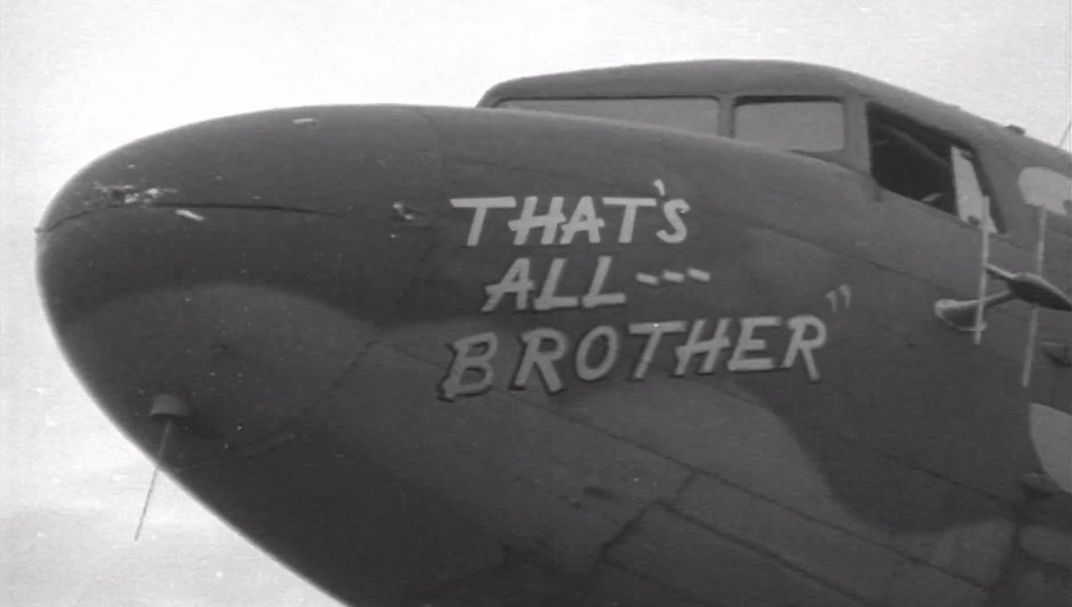Crowdsourcing Saves D-Day’s First Airplane
The C-47 that led the Normandy invasion gets a reprieve.
/https://tf-cmsv2-smithsonianmag-media.s3.amazonaws.com/filer/2b/a0/2ba04d84-2e09-409b-977d-57a1bf44845c/24d_aug2015_ddayleadairplane_jkx10594_live.jpg)
On the morning of June 6, 1944, the first Douglas C-47 Skytrain crossed the coastline of Normandy, France, and let loose the paratroopers that began the invasion. Newly painted across the fuselage was a message to Adolf Hitler: That’s All, Brother. Seventy years later, the airplane that dropped the first fighting forces sat in a Wisconsin yard, just weeks from being converted to a BT-67 turboprop.
When he discovered the aircraft’s fate, “a chill ran down my spine,” says Matt Scales, a historian with the U.S. Air Force Reserve. He sent out word to every museum and organization that might save the airplane, but couldn’t find a taker—some already had other D-Day C-47s; others simply thought Scales was wrong about the airplane’s identity. But then he received a message from Adam Smith at the Commemorative Air Force; Smith had stumbled upon a blog post about Scales’ search and confirmed the story by following the chain of ownership from the aircraft’s military days to present: He went through Federal Aviation Administration records and physically checked placards and dataplates on the aircraft to match them with the paperwork. When he confirmed the identity, “instantly you understand the significance, and the vision appears in your mind of saving and restoring the plane.” Through a crowdsourcing campaign, the CAF raised $75,000—in only 48 hours—to buy the airplane, and then increased their goal to $250,000 for the restoration.
The discovery of the D-Day leader began with a rumor. In 2006, Scales was a staff sergeant with the Alabama Air National Guard’s 106th Air Refueling Squadron. He became fascinated with the history of his squadron, especially the period in World War II when it flew B-25s in the South Pacific. One day he heard that a member of the 106th had flown the lead C-47 on D-Day. “I didn’t understand how this was possible, as, on June 6, 1944, my squadron was about as far away from Normandy as humanly possible,” says Scales.
In 2007, he volunteered for a tour with the Air Force Historical Research Agency, where he discovered records showing Lieutenant Colonel John M. Donalson, a member of the 106th in the 1930s, and then again in the late 1940s and ’50s, had been transferred to Europe when the United States entered the war and was indeed the pilot on the lead aircraft behind the pathfinders—paratroopers who had jumped into Normandy the night before to mark drop zones for the troops.
He also found the aircraft tail number, 42-92847, which had been registered as N88874 and, in 2007, was owned by someone in Mesa, Arizona. (At first Scales thought he had uncovered the Belle of Birmingham, the C-47 that the Alabama-bred Donalson ordinarily flew while abroad, but Scales discovered the pilot hadn’t wanted to cut holes, required for invasion equipment, in that airplane, so he had been assigned a new C-47, on which he had painted his message to the Nazis.)

Scales called the Arizona owner, told him the history, and found out the owner had restored the airplane to flying condition. Scales moved on, “with confidence that the current owner of the aircraft not only knew what it had done, but also that he had a love of history or else he wouldn’t have restored the aircraft as he had.” But a few years later, Scales looked up the registration again and discovered it had been sold to Basler Turbo Conversions.
Now the CAF is gearing up for a once-in-a-lifetime restoration. “The goal is crystal-clear,” says Smith, who is also in charge of building the group’s new national headquarters and aircraft museum in Dallas. “We want this to be the most authentic D-Day C-47 on the planet,” he says, adding, “and yes, that means scruffy D-Day stripes, not neatly manicured ones.” Lucky for them, they have lots of references, including film showing troops boarding the aircraft to head to Normandy.
The fundraising enabled the CAF to purchase a collection of rare parts, including radios, navigation equipment, even parts for the lavatories. The group plans to use the airplane as a “flying classroom,” where hidden speakers and sensors will re-create the experience of D-Day while schoolkids play paratroopers. Then, in 2019, the CAF plans to fly That’s All, Brother to Europe to participate in the 75th anniversary of D-Day.
Scales, meanwhile, is still searching: He wants to identify the paratroopers who jumped from That’s All, Brother that morning. That knowledge may help those who tour the aircraft better appreciate the men who stood first in line to bring an end to the largest war in history.